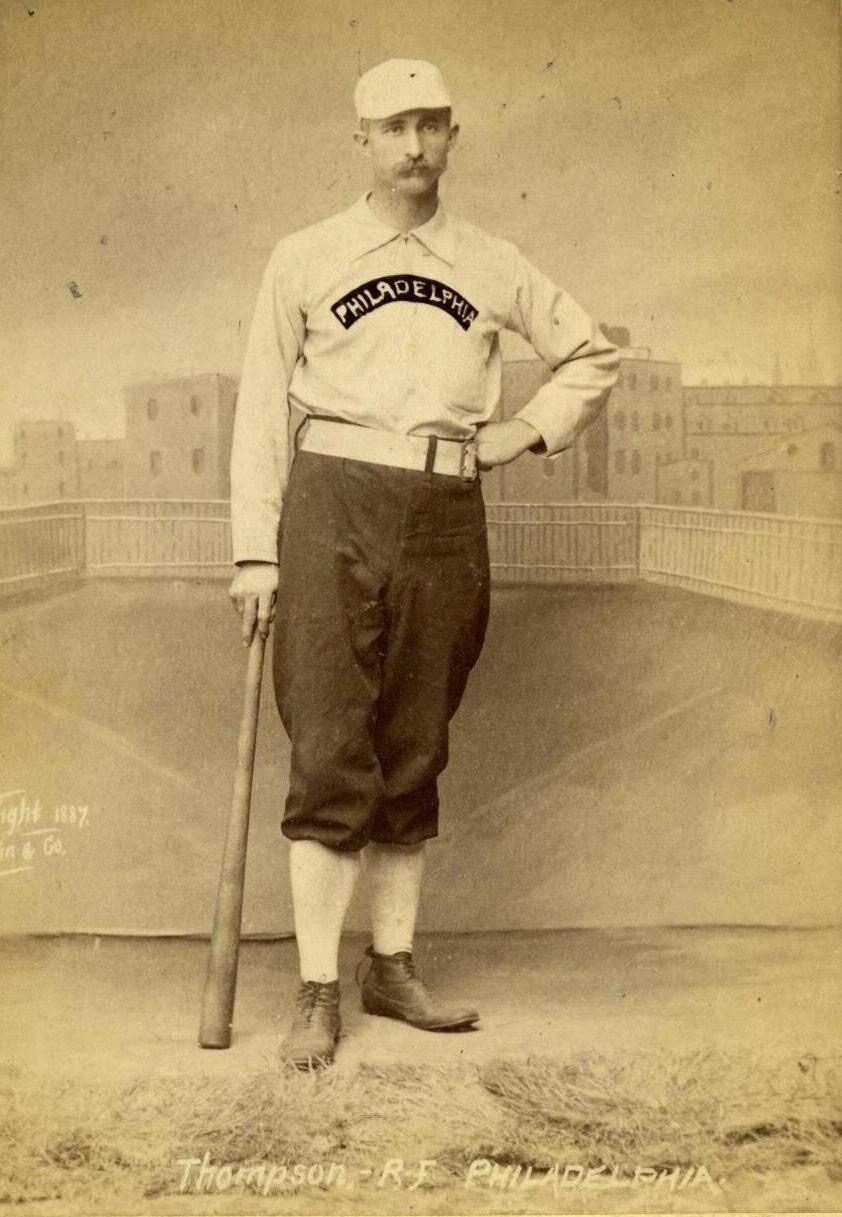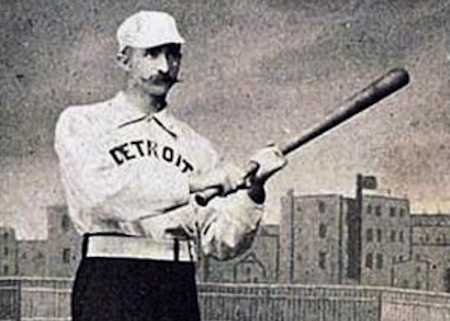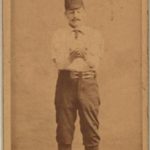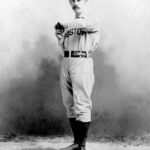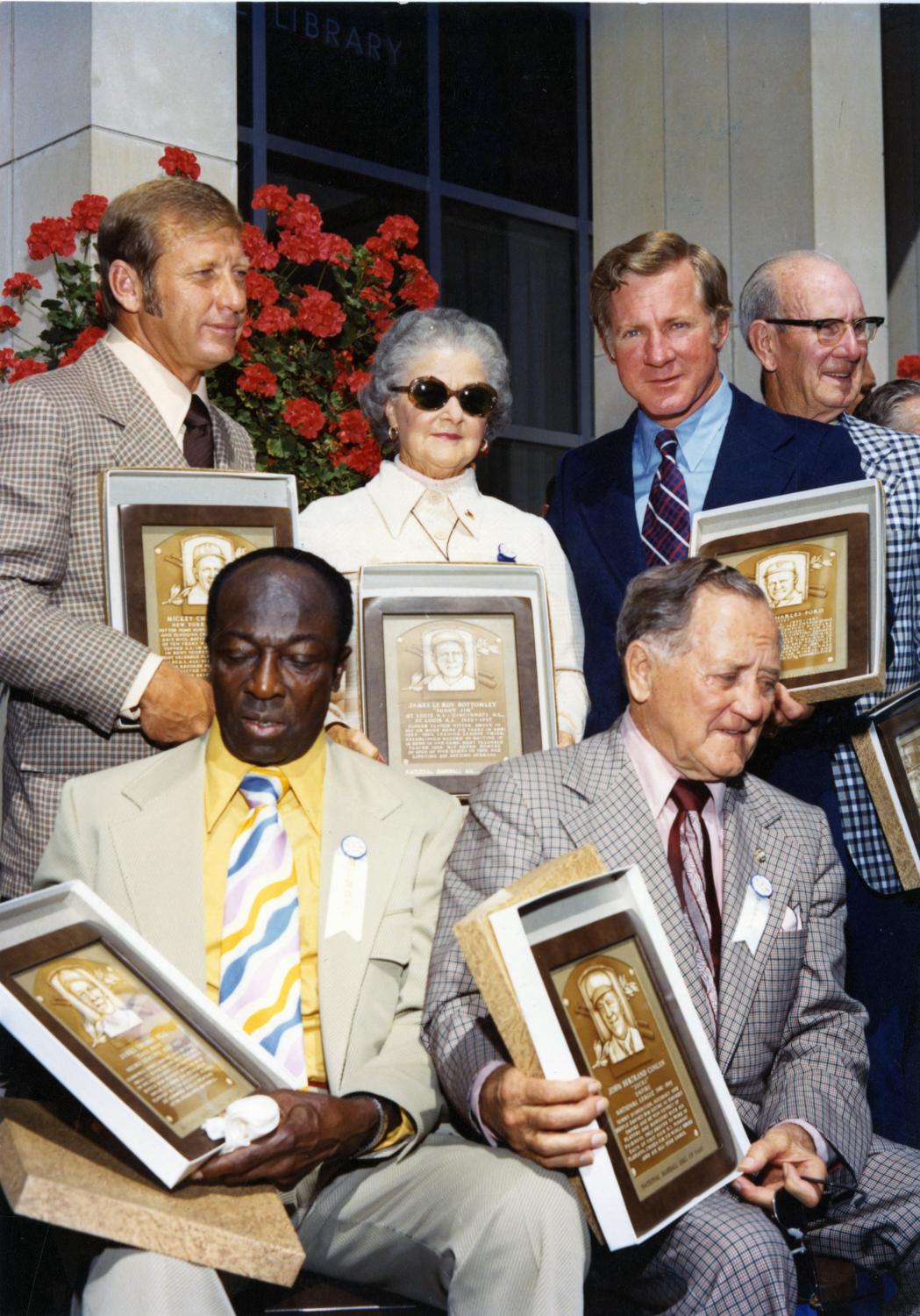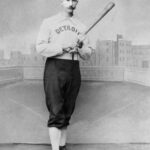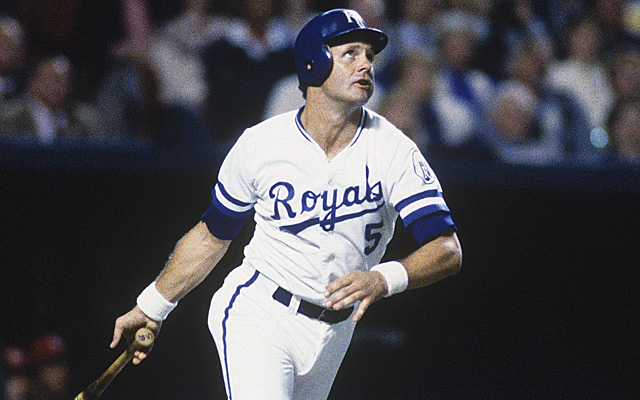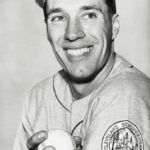Sam Thompson Stats & Facts
Sam Thompson
Position: Rightfielder
Bats: Left • Throws: Right
6-2, 207lb (188cm, 93kg)
Born: March 5, 1860 in Danville, IN
Died: November 7, 1922 in Detroit, MI
Buried: Elmwood Cemetery, Detroit, MI
Debut: July 2, 1885 (1,060th in major league history)
Last Game: September 10, 1906
vs. CHW 4 AB, 1 H, 0 HR, 0 RBI, 0 SB
Hall of Fame: Inducted as Player in 1974. (Voted by Veteran’s Committee)
View Sam Thompson’s Page at the Baseball Hall of Fame (plaque, photos, videos).
Full Name: Samuel Luther Thompson
Nicknames: Big Sam
View Player Info from the B-R Bullpen
View Player Bio from the SABR BioProject
Players Who Debuted Same Year
Coming Soon
All-Time Teammate Team
Coming Soon
Baseball is the only game you can watch on the radio. Join the community today and listen to hundreds of broadcasts from baseball’s golden age
Notable Events and Chronology for Sam Thompson Career
Biography
Described by The Saint Paul Globe as “a physical giant [who] can hit the ball harder than a mule can kick,” Sam Thompson was one of the 19th century’s greatest sluggers. In fact, the big lefty’s numbers are downright awe-inspiring. Sam compiled his first of several epic seasons with the 1887 Detroit Wolverines. That year he batted .372 with 203 hits, 23 triples, 10 home runs, and 166 RBI in only 127 games. He became the first big leaguer to collect 200 hits, and his 166 RBI—62 more than runner-up Roger Connor—stood as the single-season record until being surpassed by Babe Ruth (171) in 1921.
Upon joining the Philadelphia Quakers in 1889, Big Sam began launching home runs at a near-record pace, finishing the year with an NL-best 20 long balls to go along with 111 RBI and only 22 strikeouts. (According to historian Bill Jenkinson, Thompson routinely hit drives that traveled over 420-feet—quite an accomplishment considering the soft, lopsided spheroids that passed for baseballs in those days.)
Already a fearsome batsman, Thompson was unstoppable after the pitching distance was lengthened in 1893. That year he amassed 222 hits—37 doubles, 13 triples, 11 homers—126 RBI, and a .370 batting average. In 1894, Big Sam hit .415 with 13 big flies, 28 triples, 27 steals, and 149 RBI in only 102 games! Amazingly, the 35-year-old was just as impressive in 1895, batting .392 with 45 doubles, 21 triples, 27 stolen bases, and NL-leading totals in home runs (18) and RBI (165).
Thompson, who retired in 1898, later returned to play eight games with the 1906 Detroit Tigers—the 46-year-old hit .226 with a triple and four RBI. All told, Big Sam slashed .331/.384/.505 with 343 doubles, 161 triples, 126 home runs, 1,308 RBI, 232 stolen bases, and only 234 strikeouts over parts of 15 big-league seasons. To put it another way, he averaged 37 doubles, 14 home runs, 18 triples, 143 RBI, 25 steals, and 26 Ks per 154 games played. The 6-foot-2-inch, 207-pound basher ranked among the NL’s top six in RBI on nine occasions; home runs and total bases eight times apiece.
Thompson’s 126 long balls remained the NL record until the 1920s (Roger Connor hit 14 of his 138 homers in the Players’ League). Sam’s career ratio of one home run per every 47.6 at-bats ranks first among 19th-century sluggers. For his career, he amassed .926 RBI per game, which still stands as the all-time mark (Lou Gehrig ranks second with .922 RBI per game). Thompson was also one of the 19th century’s top right fielders. He paced NL gardeners in fielding percentage twice and for his career, averaged an astonishing 31 assists per 154 games played. Big Sam still ranks among the all-time leaders with 283 outfield assists (12th) and 61 double plays turned (15th).
In March 1907, Thompson gave an interview in which he discussed his most memorable drives. “John Clarkson was the king pin of them all,” he declared. “I remember my introduction to him. It was in Detroit in 1887. . . . He sent in a couple that were called strikes, and I asked him why he did not put them over the plate. He walked up about half way to the plate and said he did not see any medals on me giving me a license to hit any of his balls, and, going back into the box, sent a waist-high ball straight over the plate. I hit it on the nose; it went forty feet over the fence, and as I turned third base trotting in home, I told him that was where I got one medal anyhow. When I was feeling right, I could always hit John, but many is the time he made me bite the dust.
“[Amos] Rusie was always easy for me,” continued Thompson. “The first ball he ever pitched to me was at Indianapolis, and I don’t think I ever hit a ball further. It looked like it went a mile high. Frank Foreman was the hardest man for me I ever saw. One season I only made one hit off him from May to October, and that one hit his shin and I beat it out.”
After his playing days, Thompson—who had lived in Detroit since 1888—made a small fortune in real estate and later worked as a U.S. Deputy Marshall. Among the Motor City’s most respected and well-liked citizens, Sam was known for his civic-minded good works and unassailable character (not surprising for a man who was never fined or ejected from a game).
Tales of Thompson’s long ball exploits appeared in the national press for years to come. In January 1922, sportswriter Sam Crane gushed about his former teammate in an article for The Washington Times:
“Sam Thompson, one of those heavy-hitting, big left-handed batters, who was in the same class as Dan Brouthers, Roger Connor, Mike Tiernan, and others, was outstanding as a premier slugger in his day and time. Thompson was one of those dangerous men at bat whom Pitcher ‘Crazy’ Schmidt [sic] kept tabs on in a little book he carried with him. . . . His pitching instructions for Thompson read: ‘Walk him.’ . . . The writer has the idea that if Sam Thompson had stepped up on the ball instead of shifting his left foot back, he might have been as heavy a hitter as Babe Ruth. I saw Sam hit a ball far over the right-field fence on the Cincinnati ball grounds. . . . It was a whale of a wallop—a regular Babe Ruth blow.”
On November 7, 1922, Samuel Luther Thompson, age 62, passed away at his home in Detroit after suffering a massive heart attack while volunteering as an election inspector. In its coverage of Thompson’s well-attended funeral, the Detroit Free Press wrote: “Michigan’s foremost citizens—state and city officials, judges, bankers, doctors, millionaires, laborers—paid homage . . . to their beloved friend.”
The Philadelphia Public Ledger ran a glowing obituary that read in part:
“The idol of another generation of baseball fans has made his final gesture to those who applauded him and passed into the beyond. Many wonderful hitters have held the spotlight since baseball graduated from its infancy—from the days of Cap Anson to the current ones of Babe Ruth. . . . For sheer murderous hitting power, Thompson never conceded first place to any of them. . . . Some had higher averages, but none hit more savagely. In Thompson’s day, there were no plethora of home runs, as has been common during the last few years. Yet he crashed out 127 [sic] of them during his career. Among more modern National Leaguers, only Honus Wagner and Gavvy Cravath were able to pass the 100 mark in home runs.”
Shortly after Thompson’s death, sportswriter George Chadwick interviewed Babe Ruth, who was eager to learn more about the National League home run king:
▪️Ruth: “What kind of batter was this Sam Thompson? Did he hit like me?”
▪️Chadwick: “No, he had a different swing from yours. He was a left-hander, as you are, but he did not swing from over the shoulder.”
▪️BR: “Some push, was he a big fellow?”
▪️GC: “Yes, bigger than you are—taller and not so big around but with more
massive legs.”
▪️BR: “Could he hit as far as I have done?”
▪️GC: “Sometimes, although he may never have hit one as far as your farthest.”
▪️BR: “Some bust I gave that old apple out in Detroit once. They say it was the longest ever made. Thompson died in Detroit. Maybe he saw me hit that one.”
“Gentlemen, you all know Mr. Thompson. He is about to bat. You can kiss the ball goodbye.” — Buck Ewing
✍️ Bobby King II
☑️Sources: https://chroniclingamerica.loc.gov + https://www.baseball-reference.com + https://nyshistoricnewspapers.org + https://en.wikipedia.org
@ET-DC@eyJkeW5hbWljIjp0cnVlLCJjb250ZW50IjoicG9zdF90YWdzIiwic2V0dGluZ3MiOnsiYmVmb3JlIjoiTGVhcm4gTW9yZSBhYm91dCB0aGUgdGVhbXMsIHBsYXllcnMsIGJhbGwgcGFya3MgYW5kIGV2ZW50cyB0aGF0IGhhcHBlbmVkIG9uIHRoaXMgZGF0ZSBpbiBoaXN0b3J5IC0gLSAtIC0gLSAtIC0gIiwiYWZ0ZXIiOiIiLCJsaW5rX3RvX3Rlcm1fcGFnZSI6Im9uIiwic2VwYXJhdG9yIjoiIHwgIiwiY2F0ZWdvcnlfdHlwZSI6InBvc3RfdGFnIn19@
Baseball is the only game you can watch on the radio. Join the community today and listen to hundreds of broadcasts from baseball’s golden age
Factoids, Quotes, Milestones and Odd Facts
When Babe Ruth hit his 128th career homer, in 1921, it was Sam Thompson’s career record that he broke. Unfortunately, Thompson has been forgotten ever since. But in the 1890s he was an extremely popular ballplayer, teaming with Ed Delahanty and Billy Hamilton to form one of the greatest outfields in baseball history during his stretch in Philadelphia. An imposing figure with a very strong throwing arm, Thompson was one of the first outfielders to perfect the one-bounce throw to home plate and other bases. He led the league in eight different batting categories during his amazing career, and belted his last homer at the age of 46. He was elected to the Hall of Fame in 1974, 55 years after his death
Played For
Detroit Wolverines (1885-1888)
Philadelphia Phillies (1889-1898)
Detroit Tigers (1906)
Similar: Dan Brouthers, Jim O’Rourke
Linked: Charlie Bennett, Billy Hamilton, Ed Delahanty, Dan Brouthers, Babe Ruth
Best Season, 1895
He hit .407 in 1894, but in ’95 he had an evern better year. That season, “Big Sam” collected 211 hits in 119 games, scored 131 runs, clubbed 45 doubles, 21 triples, and 18 homers, and plated 165 runs. He hit .392 and helped Philadelphia’s offense rack up more than 1,000 runs.
Post-Season Appearances
1887 World Series
Description
“This magnificent specimen of manhood serves numerous noble purposes. Indiana is proud of him because he is her honored son; Michigan is proud of him because he is fighting under her banner; Illinois is proud of him because he is maintaining the glory of the league to which she belongs; men everywhere are proud of him because he so splendidly illustrates well-applied virility, and women all adore him because there is combined with his superb athletic qualities a modesty that is inexpressibly charming.” — from a clipping from an unknown newspaper, dated October 20, 1887
“Thompson was an ungainly ballplayer who violated every rule when it came to taking his stance at the plate.” — Indianapolis Times, March 26, 1961
Where He Played: Outfield, some first base, and one game at third. Thompson was basically a left fielder.
Big League Debut: July 2, 1885
The story goes that Thompson was working as a carpernter when he was signed to play professional baseball. The manager of the Indinapolis Indians was searching for players to make a team to oppose his own club of nine. He was told of Thomspon, but warned that Sam was working as a tradesman and wouldn’t be easily lured onto the field. When the manager found Thompson on a ladder, he made his sales pitch. Sam replied that he’d love to play ball but he loved to eat as well, and that he wasn’t sure he could make enough playing a game. The manager offered Sam $5 to play against his team. Thomspon accepted, belted a home run to deep center field in his first game, and was a professional batsman from that point forward.
Batting Feats
-
- August 17, 1894: Cycle…
Hitting Streaks
21 games (1887)
“Big Sam Thompson Goes Down Trail”
The above was the headline in a November 1916 newspaper report on Sam Thompson, who “professed the Christian religion at the last meeting of Billy Sunday’s revival which closed at Detroit…” The article explained that Thompson and former teammate Charlie Bennett both went to the front of the revival and expressed their desire to find their religion. Bennett, who had lost his legs in a railroad accident years earlier, was embraced by Sunday, the popular evangelist of the period. According to the newspaper, Sunday’s efforts netted more than $50,000 in contributions.
The Detroit Athletic Club
Thompson was still a good ballplayer when he left the Philadelphia team early in the 1897 season. It’s likely that he abandoned the team after just thre egames, for a couple of reasons:
1. He was, at age 37, one of the oldest players in the league, and many of his longtime teammates had either retired or been traded away in recent years.
2. He made his home in Detroit and had been playing ball away from his wife and family for nearly a decade.
3. His skills had deteriorated some, and he was aware that he couldn’t hit the ball as well as he could in his prime.
The second reason is most likely to be the main factor in his decision to leave the team early in ’97. He was coaxed back in the spring of ’98, and reported, mostly out of habit. He hit well for 13 games and then left for Detroit once again. Within a few years he was back on the diamond, playing for the Detroit Athletic Club, a talented semi-pro team in the city. The team was popular enough to have actually outdrawn the Tigers in some seasons. Later, in 1906, in what was essentially a publicity stunt, Thompson played the final week of the 1906 season for the Tigers, at the age of 46. With the Bengals, “Big Sam” played in the outfield alongside Ty Cobb and Sam Crawford, two future Hall of Famers.
North or Southpaw?
Some of Thompson’s descendents have argued that Big Sam actuall threw with his right hand, but the evidence suggests they are mistaken. His arms was so strong, it’s likely Thompson would have been utilized at third base more often had he been a right-handed thrower.
Quotes About Thompson
“[Thompson is from the] rutty class of slugging batsmen, who think of nothing else when they go to the bat but that of gaining applause of the ‘groundlings’ by the novice’s hit to the outfield for a ‘homer,’ one of the least difficult hits known to batting in baseball, as it needs only muscle and not brains to make it.” — The 1896 Spalding Guide
Best Strength as a Player
Hitting for power, and his throwing arm. Thompson is credited with perfecting the one-bounce throw from the outfield.
Largest Weakness as a Player
None that we’re aware of.
Other Resources & Links
Coming Soon
If you would like to add a link or add information for player pages, please contact us here.

